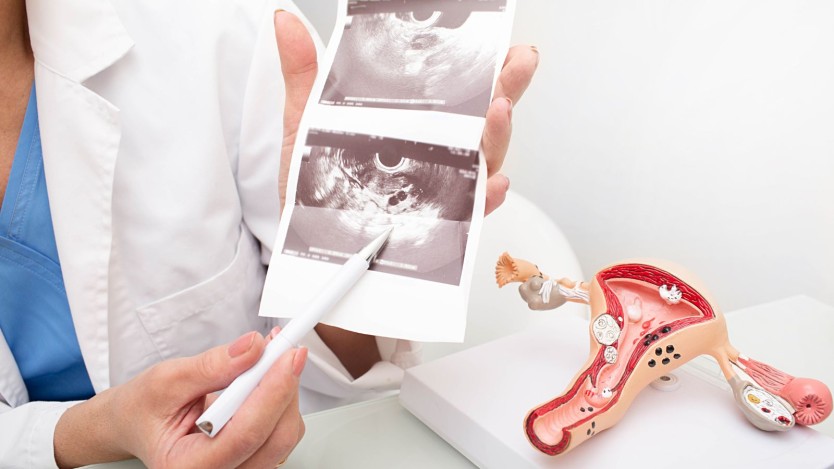Postoperative period after hysterectomy surgery

- What is a hysterectomy?
- Hysterectomy approaches (interventions)
- Postoperative period after hysterectomy
- Postoperative of hysterectomy in hospital
- Postoperative period at home after a hysterectomy by laparoscopy
- What to do during the postoperative period after hysterectomy
- Hysterectomy surgery involves the removal of the uterus or the uterus together with other nearby organs or structures.
- Hysterectomy surgery can be approached in three different ways: abdominal, vaginal or laparoscopic.
- The duration of the postoperative period will be longer or shorter depending on the approach technique used by the surgeon.
What is a hysterectomy?
A hysterectomy consists of the removal of a woman's uterus as a result of uterine cancer, uterine fibroids (benign pelvic tumours), endometriosis, etc. In other cases, there are patients who decide to undergo a hysterectomy for other reasons, such as unexplained heavy menstrual bleeding or menstruation.

Do you need hysterectomy surgery?
Request a free and immediate appointment with our specialists in Gynaecology
In addition to the uterus, the surgeon may sometimes consider removing other structures or organs that may also have been damaged. Therefore, depending on the organs that are removed, we can differentiate between four types of hysterectomy:
- Total hysterectomy: this consists of the removal of the uterus and the cervix (lower part of the uterus).
- Partial (or subtotal) hysterectomy: consists of the removal of the uterus, keeping the cervix and ovaries intact.
- Radical hysterectomy: involves the removal of the uterus, the cervix, the upper part of the vagina and all surrounding lymph nodes and ducts.
- Total hysterectomy plus double adnexectomy: consists of the removal of everything mentioned in the radical hysterectomy plus the two fallopian tubes.

Each of these types of hysterectomy will be performed depending on the surgeon's opinion and the severity of the problem.
Hysterectomy approaches (interventions)
A hysterectomy can be performed in different ways. It all depends on the gynaecologist's experience with each approach, the size of the uterus and the reason for the hysterectomy. There are three different types:
- Abdominal hysterectomy: this is the most commonly used technique. It consists of making an incision in the lower abdomen.
- Vaginal hysterectomy: this is performed through the vagina. The advantage over the other two types of hysterectomy is that it leaves no visible signs of the operation.
- Laparoscopic hysterectomy: the surgeon combines the vaginal hysterectomy with the use of a laparoscope to perform the operation.
After completion of the procedure, the patient will enter the postoperative period.
Postoperative period after hysterectomy
It should be noted that the postoperative period following a hysterectomy will vary depending on the technique used.
In the case of an abdominal hysterectomy, it will require more days in hospital after the operation, as well as more days of recovery.

In contrast, vaginal and laparoscopic vaginal hysterectomies require a shorter hospital stay and recovery time. It should also be noted that these are operations that, when performed correctly, have a very low number of postoperative complications.
After hysterectomy, the patient may spend two to three nights in hospital, after which she can go home on her own.
Postoperative of hysterectomy in hospital
Regardless of the technique used to perform the operation, the patient will be woken up in the operating theatre. When she is able to move and speak properly, she will be moved to the resuscitation room, where she will finish recovering and the necessary analgesic medication will be administered.
When she is fully awake, the patient will be taken to her room.
If the technique used to perform the hysterectomy is laparoscopic, the hospital stay is only two days, unlike vaginal and abdominal hysterectomies, which can take up to three days.
As for postoperative pain, it should be noted that it is usually less with laparoscopic hysterectomy than with abdominal hysterectomy.

Do you need hysterectomy surgery?
Request a free and immediate appointment with our specialists in Gynaecology
During the first few hours, the patient will be fed and hydrated by means of drips, and shortly afterwards (approximately 6 hours after the operation) she will begin to take liquids orally.
After 12 hours, a semi-liquid diet will be started and 12 hours after the operation, the diet will change to a soft diet. Between 24 and 48 hours after surgery, the patient should have fully recovered digestive function.

After this time, or perhaps one more day if the hysterectomy was abdominal or vaginal, the patient can go home and continue post-operative care there.
Postoperative period at home after an abdominal hysterectomy
You should bear in mind that the postoperative period following an abdominal hysterectomy may last up to 8 weeks, by which time in most cases the patient is fully recovered.
Once at home, the patient should take the painkillers previously prescribed by the specialist to control abdominal pain.
You should also avoid lifting, driving or going up and down stairs for the first few days, as these activities can have a negative impact on the abdominal area. Another thing that patients who have undergone abdominal surgery should avoid is taking baths so that the surgical wound does not get wet, which could facilitate infection and hinder healing. On the other hand, you can take showers with care.
It is important to avoid sexual relations and, above all, to avoid alcoholic drinks until the specialist indicates it.
Postoperative period at home after a vaginal hysterectomy
The postoperative period normally lasts 3 to 6 weeks. During the first 2 - 4 weeks, the patient may have a slight red or pinkish spotting which should not have a bad odour. If this is the case, you should consult your specialist as it could be a sign of infection.
As with the abdominal hysterectomy, do not lift, drive, walk up and down stairs or play sports. You should also not have sexual intercourse or insert anything inside the vagina until the gynaecologist considers it necessary (usually for the first 8 - 12 weeks after the operation).
You should also take the painkillers prescribed by the specialist to alleviate pain.
Postoperative period at home after a hysterectomy by laparoscopy
As mentioned above, recovery time will be shorter with this technique. The postoperative period will be approximately 2 to 6 weeks.
In this case, you may be able to drive for 2 to 3 days after the operation if your doctor has not prescribed pain killing medication.
As above, no heavy lifting and sexual intercourse should not be resumed for 8-12 weeks.
What to do during the postoperative period after hysterectomy
Despite all the things that cannot be done depending on the type of intervention, there are many other things that can be done and that are also recommended to reduce recovery time. These activities are common to any type of intervention.
Normal activities that the patient used to do before the operation should be resumed immediately, such as walking, housework, etc., as long as they do not involve any strain on the abdominal area.
Another thing to consider is your diet: to avoid constipation you should eat fruits and vegetables, cereals and drink plenty of water. In some cases, the doctor may recommend that you take a laxative.
In hysterectomy with laparoscopy, the patient will be able to return to work approximately two to three weeks after the operation, which will be more delayed if the patient is operated on using the other two approaches and will depend on the type of work she does.
This advice should be recommended by the gynaecological specialist. After the recovery period, patients return to their daily lives as soon as possible and the symptoms and discomfort disappear completely.

Do you need hysterectomy surgery?
Request a free and immediate appointment with our specialists in Gynaecology
Medical disclaimer: All the published content in Operarme is intended to disseminate reliable medical information to the general public, and is reviewed by healthcare professionals. In any case should this information be used to perform a diagnosis, indicate a treatment, or replace the medical assessment of a professional in a face to face consultation. Find more information in the links below:
